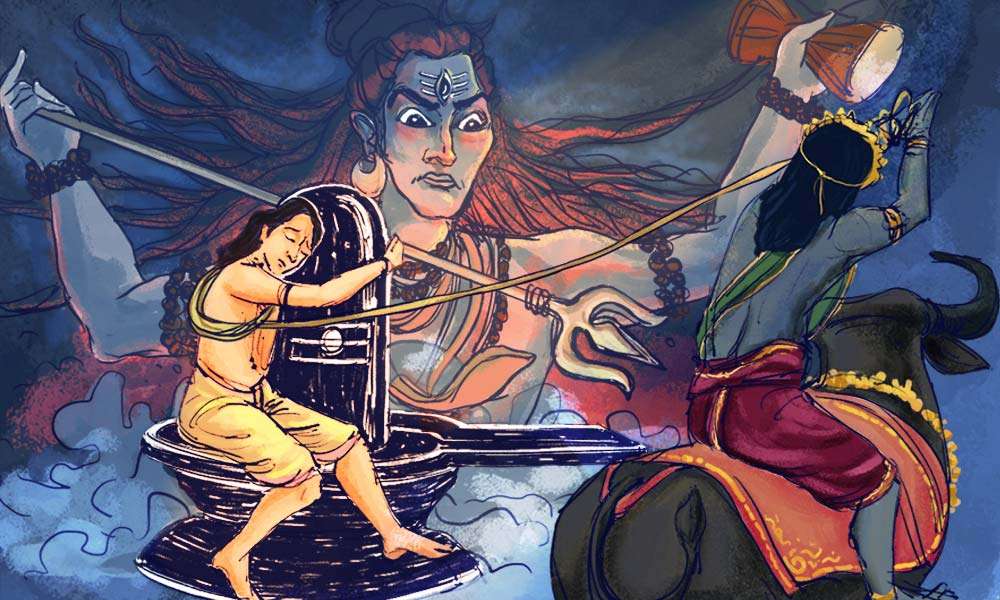[Markandeya]
Ancient Hindu sage who sought divine grace to triumph over death and was thus blessed to remain sixteen forever. His story stands testimony to the transformative power of human responsibility: he learned how to become available to grace and thereby transformed his destiny.

The Story of Markandeya and Kalabhairava
Sadhguru: Markandeya was a child for whom a choice was made before he was born. His parents had to choose between having a son who would live for a hundred years but would be a fool, or a son who would be a brilliant, shining being but live only for sixteen years.So, when the moment of his death came – when the god of death, Yama, came to claim his life – Markandeya did one simple act.The parents were wise and they chose the latter, and they bore a brilliant, shining child of enormous capabilities. But as days passed and years rolled by, they were worried for their child and became very tortured as the date of his death came close. They explained to Markandeya about the boon they had received and the choice they had made. But Markandeya was phenomenally wise and knowledgeable, and he knew the ways of life. So, when the moment of his death came – when the god of death, Yama, came to claim his life – Markandeya did one simple act. There was a linga that was particularly consecrated as Kalabhairava. Markandeya just held the linga. The moment he held the linga, time came to a standstill and death could not approach him. Yama was held right there. Within Markandeya, that dimension of consciousness had opened up where he was not available to time any more. They say he continued to live as a fifteen-year-old boy, never turning sixteen because he came in touch with that dimension of consciousness which we refer to as Kalabhairava. It is only because time exists that there is something called as death. Kalabhairava is that dimension of consciousness which can go beyond time.
▵ Going Beyond Time
One dimension of yoga is that you are able to go beyond physical nature. If your experience of life is such that your identification with the physical has become minimal, time does not matter any longer. Once there is a distance from your physical nature, time has no power over you. Kalabhairava means one who has mastered time or has killed time. Time is a consequence of your physical nature, and your physical nature is a consequence of time. It goes both ways because everything that is physical in the universe is naturally cyclical. Whether it is the atomic or cosmic, everything is in cycles. Without cyclical movement, there is no possibility of physicality. However, if you bring your physical body to a certain state of ease, in a way, you have control over time. If you bring yourself to a state where there is a certain distance between you and your physicality, your physical nature has been kept aside, so time simply does not exist for you. Once there is distance, there is no time at all in your experience. Then we say you are a Kalabhairava.
Chandrashekhara Ashtakam
Chandrashekara Ashtakam is said to have been written by Sage Markandeya.It is said that at the age of sixteen, Markandeya was saved by Shiva from the God of Death (Kala or Yama). In these verses, Markandeya seeks refuge in Shiva, referred to here as Chandrashekara (the one who wears the crescent moon on his head). “When He is by my side, what can Yama do to me?” he proclaims.
Lyrics:
Chandrashekhara chandrashekhara chandrashekhara pāhimām
Chandrashekhara chandrashekhara chāndrashekhara raksha mām
Ratnasānusharāsanam rajatādri shrunga niketanam
Sinjinikruta pannageshwara achyutānana sāyakam
Kshipra dagdha puratrayam tridivālayairabhi vanditam
Chandrashekharamāshraye mama kim karishyati vai yamah
Pancha pādapa pushpa gandha padāmbuja dwaya shobhitam
Bhālalochana jātapāvaka dagdha manmatha vigraham
Bhasma digdha kalevaram bhava nāshanam bhavamavyayam
Chandrashekharamāshraye mama kim karishyati vai yamah
Matta vārana mukhya charma krutottareeya manoharam
Pankajāsana padmalochana pujitānghri saroruham
Deva sindhu tarangaseekara sikta shubhra jatādharam
Chandrashekharamāshraye mama kim karishyati vai yamah
Yaksharāja sakham bhagāksha haram bhujanga vibhushanam
Shaila rājasutā parishkruta chāru vāma kalevaram
Kshweda neela galam parashwadha dhārinam mrugadhārinam
Chandrashekharamāshraye mama kim karishyati vai yamah
Kundalikruta kundaleshwara kundalam vrusha vāhanam
Nāradādi muneeshwarastuta vaibhavam bhuvaneshwaram
Andhakāndhaka māshrita amarapādapam shamanāntakam
Chandrashekharamāshraye mama kim karishyati vai yamah
Bheshajam bhavaroginam akhila pādamāmpaharinam
Dakshayagnavināshanam trigunātmakam trivilochanam
Bhuktimukti phalapradam sakalāghasangha nivāranam
Chandrashekharamāshraye mama kim karishyati vai yamah